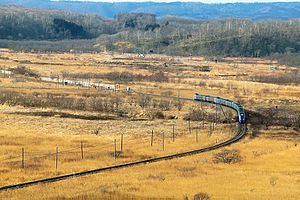Termini TakikawaNemuro Opened 1901 | Locale Hokkaido Stations 68 Line length 443.8 km (275.8 mi) | |
 | ||
Nemuro Main Line (根室本線, Nemuro Honsen) is a railway line in Hokkaido operated by Hokkaido Railway Company (JR Hokkaido), connecting Takikawa Station in Takikawa and Nemuro Station in Nemuro, including Obihiro and Kushiro. Higashi-Nemuro is the most easterly situated station on the Japanese rail system.
Contents
- Services
- Stations
- History
- Service augmentations
- Ashibetsu area
- Shintoku area
- Obihiro area
- Shakubetsu Higashi Kushiro section
- Hamanaka Nemuro section
- References
On 19 November 2016, JR Hokkaido's President announced plans to rationalise the network by up to 1,237 km, or ~50% of the current network, including closure of the Nemuro Line between Furano and Kami-Ochiai Junction. The section between Kushiro and Nemuro is proposed for conversion to Third Sector operation, but if local governments are not agreeable, such sections will also face closure.
Services
The line is roughly divided into three segments. The segment between Takikawa and Shintoku is now a quiet local line. The rapid train Karikachi (狩勝) runs twice a day, and there is one local train service every 1 to 2 hours.
The segment between Shintoku and Kushiro remains a part of the important trunk route between Sapporo and eastern Hokkaido. The limited express train Super Ozora runs between Sapporo and Kushiro six times a day, while the Super Tokachi runs twice a day, Tokachi four times a day, both between Sapporo and Obihiro. There is one local train service every 1 to 2 hours.
The segment between Kushiro and Nemuro is again a quiet local line. This segment has the official nickname Hanasaki Line (花咲線, Hanasaki-sen). There are two rapid trains Nosappu (ノサップ) and Hanasaki (はなさき) which run once a day each. Other than that, there is one local train service every 2 to 3 hours.
Stations
LE: Limited expressR: RapidAll trains stop at stations signed "+". Some trains stop at "*". No trains (other than local) stop at "-".History
The line was built as a link line between central and eastern Hokkaido, by Hokkaido Government Railway (北海道官設鉄道, Hokkaidō Kansetsu Tetsudō). The first section, originally included as part of the Nemuro Line, become classified as the Furano Line in 1913.
The first section of the current Nemuro Line was opened between Kushiro - Shiranuka in 1901. The line was extended westward, reaching Furano in 1907. In 1913 the Furano - Takikawa section opened, shortening the route by 53.5 km.
The first section of the line east of Kushiro opened in 1917, reaching Nemuro in 1921.
In 1966, two major deviations opened, the first, east of Kanayama, associated with the construction of the Kanayama Dam, and the second between Ochiai and Shintoku, including the 5,790 m Shinkarikachi tunnel allowing the line to bypass the 1907 Karikachi tunnel and associated 1 in 40 (2.5%) grades.
In 1981, the Sekishō Line opened between Shin-Yubari and Shintoku, becoming the main route between central and southeastern Hokkaido and shortening the distance for stations east of Shintoku to Sapporo by 43.4 km.
In 1990, a new tunnel and associated alignment opened near Atsunai, and a deviation near Shimanoshita associated with the construction of the Takisato Dam was opened in 1991.
Service augmentations
In 1911, 1st class sleeping accommodation was included on the Hakodate to Kushiro train, and a dining car was added from 1916.
In 1971, a refrigerated container train was introduced between Kushiro and Tokyo.
Ashibetsu area
The Mitsubishi Mining Co. opened an 8 km line to Penke Sanko in 1949, and a 1 km branch to the Yuya mine in 1954. Both closed with the mine in 1964.
A 762 mm (2'6") gauge logging tramway was operated from Kamiashibetsu commencing 1934. By 1954 it had a 31 km 'main line' and 5 branches totalling 44 km. The lines closed 1961 when log trucks replaced the tramway.
Shintoku area
Obihiro area
The 78 km Shihoro line to Tokachi Mitsuma opened in sections between 1925 and 1939. An 18 km deviation built in association with the Nukabira Dam opened in 1955. The line closed in 1987.
The 84 km Hiroo line opened between 1929 & 1932 and was closed in 1987. A proposal to extend the line to Samani and connect to the Hidaka Main Line did not eventuate.
A 4 km private 1067mm (3'6") line connected a sugar beet factory to Obihiro. The sugar beets were transported to the factory by a 3 line 762mm gauge network totalling 59 km, which operated 1924-77.
